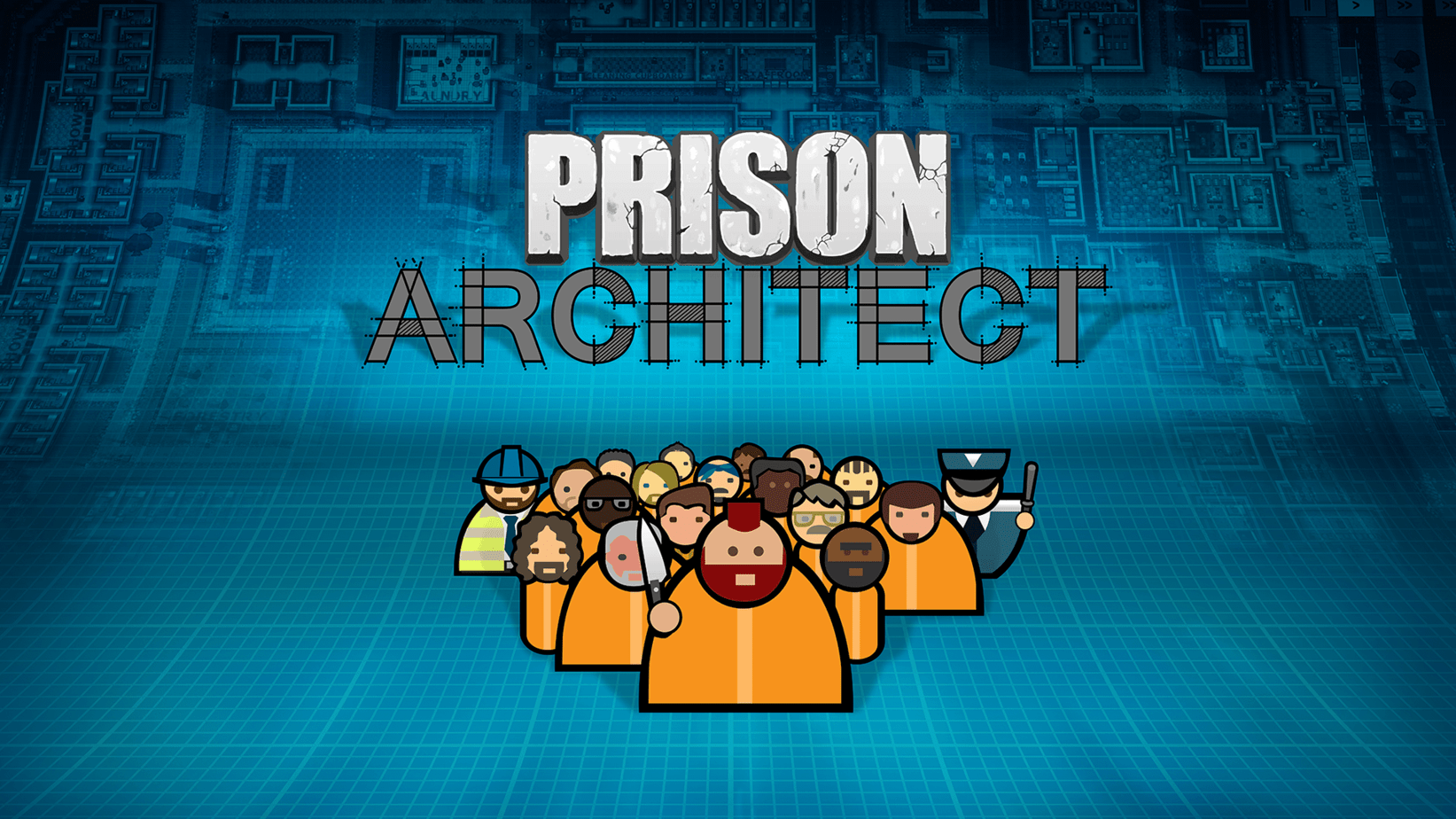
In Prison Architect: Cardboard County Penitentiary 1-4 Wardens compete to create the best and most efficient prison the governor could possibly imagine! How you do that is your choice, Warden!
SET UP
Player Setup
- Each player picks a Warden piece, takes a player board, bid board, player screen, and a frame, and places these in front of themselves.
- Each player places the Finance and Rehabilitation tokens on the 1st space of each relevant track on their player board and fills the slots at the top of their player board with 10 each of the relevant Status cubes.
- Deal 1 Bunk Cell and 1 Locker Room tile next to the Construction area of each player’s Prison Grounds frame.
- Separate the Objectives by type (Starter, Easy, Hard) – each has a different back. Shuffle each deck separately.
- Deal 1 Starter Objective face-up next to the Objectives area of each player’s Prison Grounds frame.
- Deal each player 1 Starter, 1 Easy, and 2 Hard Objectives, which they take in hand, hidden from other players.
- Return unused Starter Objectives to the box.
- Give each player $40 (we recommend 2x 10, 3×5 and 5x 1 or similar) and 5 Staff Meeples.
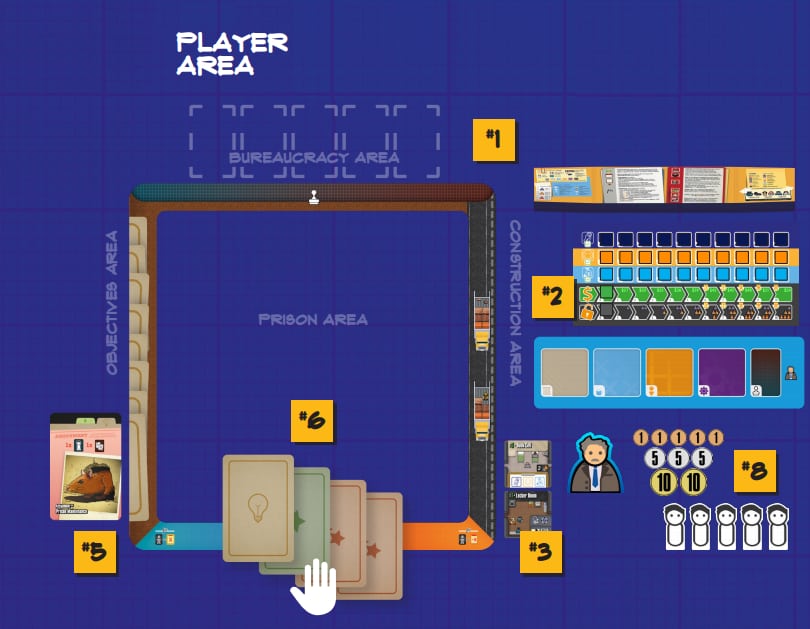
General Setup
- Place the Central Board in the centre of the playing area. Put the Escapee dice nearby.
- Place 1 of the round trackers on the ‘Foundation’ ( ) space on the Central Board. Keep the other nearby.
- Place the Bunk Cells and Locker Rooms in their own stacks, face-up, near the Central board.
- Create a shuffled, face-down pile of each of the 4 room tile types (Cells, Staff Facilities, Basic Facilities, Additional Facilities) and Bureaucracy cards and place them near the Central Board. For each pile, leave space for a discard pile, and for 4 tiles / cards to be revealed.
- Put the Prisoner tiles of each type in 3 separate face-down supplies in the centre (the backs of each type match)
- Shuffle the remaining Easy and Hard Objective decks and place them within reach of all players. (Starter Objectives unused during Player Setup should be returned to the box).
- If playing a 1 or 2-player game: Shuffle all 20 Warden Duel cards into a face-down pile. Flip the top card faceup. Otherwise, return them to the box.
- Form a supply of the other pieces (windows, Staff / Specialist meeples, coins, and Wildcard tokens) in reach of all players.
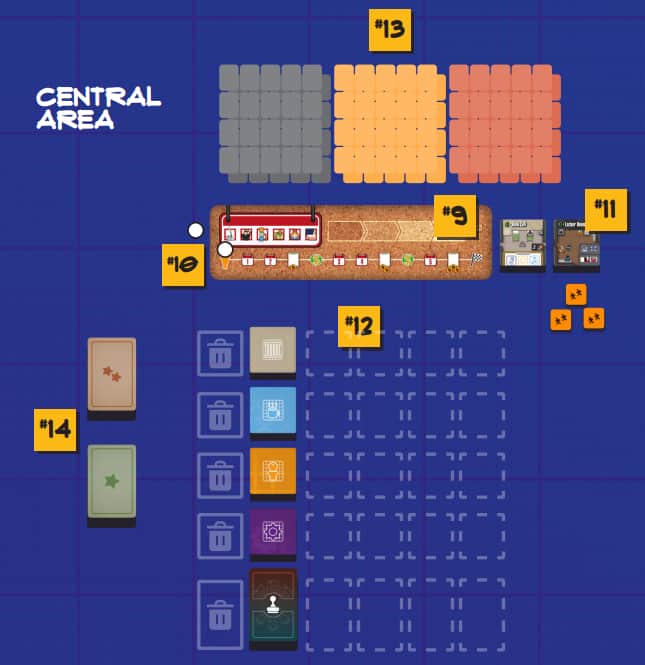
HOW TO PLAY
A game of Prison Architect is played over several rounds, each of which is broken down into phases. The Central Board shows you which rounds happen when:
THE FOUNDATION ROUND – Reveal 1 tile from each of the 4 face-down piles of room tiles for all players to see. Randomly determine a starting player, and from that player clockwise, each player must either:
- Purchase 1 of the revealed room tiles by paying its printed minimum cost, place their Warden piece on the lowest available space on the Initiative track, and put the tile in their Construction Area (the space to the right of their prison area) OR
- Place their Warden meeple on the highest available space on the Initiative track Once all players have chosen, discard any tiles not selected by anyone.
THE WORKING WEEK – The bulk of the game takes place in the 5 ‘Working Week’ rounds. Each of these is broken down into 6 phases:
- Cleanup – Each Cleanup phase, discard any tiles/cards still in the offer areas into their respective discard piles, then set up the offer according to the number of players.
- Bid – Hidden behind their player screen, each player allocates some or all of their cash to some or all of the Bid Areas shown on their bid board. When all players have done this, all players move their screens aside to reveal all bids.
After bids are revealed, players may only alter their bids with an ability that explicitly allows it. All the Bid boards are moved to the centre of the table in clear view of everyone. - Buy – In the Buy Phase, players can buy tiles/cards from each category: Cells, Basic Facilities, Additional Facilities, Staff Facilities and Bureaucracy. Repeat these steps until each category has been resolved, after which all players’ bid boards should be emptied of money.
- Build – In the Build phase, players add the tiles they’ve bought to their prison.
- Intake – In this phase, players may add prisoners to their prison. Each player declares how many prisoners of each type (grey, orange, red) they’re taking, considering the following rules:
- Prisoners must be placed in a cell. Each cell has a capacity printed on it
- You may intake any number of prisoners in a round, as long as you have space. Don’t worry if you intake a few, and then realize you can take more, just take them. However, once you have taken a prisoner, you may not refuse to place them or return them to the supply.
- Once a prisoner is in a cell, they stay there until they either escape or are released
- The state pays out for each prisoner you take. Immediately receive $1 per grey prisoner, $2 per orange prisoner, and $3 per red prisoner you take.
- Set Objectives – all players commit to objectives. Each player must either:
- Play 1 Objective from their hand into their Objective Area, and discard another, OR
- Play 2 Objectives from their hand into their Objective Area
They then draw 2 Easy and 2 Hard objectives, choose 2 out of the 4 to add to their hands and discard the remainder.
**You can use the 2nd tracker to mark which phase you’re in on the top-left corner of the central board.**
EVALUATION ROUNDS – Each game has 3 Evaluation Rounds. In an Evaluation Rounds, perform the following steps:
- Each player should double-check their prisoner needs (Security, Comfort, Hygiene), check their Finance and Rehabilitation tracks are correct
- Prisoners Escape: Roll 1 / 2 / 3 Escape dice (for the 1st / 2nd / 3rd Evaluation, respectively, as shown on the Central board). Count the total number of Escapee icons on the dice. All players simultaneously move that many prisoners from unsecured cells to the ‘Escaped’ area of their prison frame, starting from the unsecured prisoner with the highest threat value, then in descending order of threat value.
- Release Prisoners: Each player may release prisoners up to the indicated amount on the step they currently occupy on their Rehabilitation track. Move the released prisoners to the Released area of your player board.
- If this is the 1st / 2nd Evaluation Round, discard every Staff meeple (back into the supply) from Locker Rooms (and only from Locker Rooms). In the last Evaluation, Staff meeples stay on Locker Rooms to count towards Blueprints.
- Proceed either to an Income Round or to Final Scoring.
INCOME ROUNDS – During an Income Round each player gains cash from the bank as shown on their Income track. If a player has over 10 Finance tags, they receive income as if they had 10.
END OF THE GAME
At the end of the game, players calculate their Victory Points. Discard unplayed Objectives from your hand; they no longer matter. Then, score as follows:
- Cash: Every $2 of leftover cash is worth 1 VP.
- Brick and Mortar: Most tiles have a VP value in their top-right corner. Some have a conditional VP value in their lower-right corner. Conditional VP is only awarded if you meet the condition at the time of scoring.
- Organization: Some Bureaucracy cards have conditional VP values, as with tiles. Evaluate these now.
- Finances & Rehabilitation: Receive VP shown on your Income and Rehabilitation track positions, if any.
- Specialists: Receive 1 VP per Specialist you have in your prison (Guards, Dogs, Trainers, Librarians, Nurses, and Custodians), regardless of whether they are assigned to a cell or not.
- Objectives: Check all Objectives played into your Objective Area: for each completed Objective, score the positive VP value (green). For each incomplete Objective, lose the indicated negative VP value (red), if any such value is indicated.
- Escapees: Lose VP equal to the total threat value (the number printed in the lower-left on a prisoner tile) of all your escaped Prisoners.
- Reintegration: Gain VP equal to the total threat value of all your released Prisoners.
- Inmates: Score 1 VP for each prisoner in a Hygienic OR Comfortable cell. Score 3 VP instead for each prisoner in a Hygienic AND Comfortable cell.
The player with the highest VP wins, in case of a tie players share the victory.

First Thoughts
I was so surprised to get this game, as though I knew Prison Architect: Cardboard County Penitentiary was being made I thought wasn’t going to be released until late next year…. Then I got nervous, as I love the video game & I have had some mixed feelings about many video game adaptions. As they often miss the mark or fall short
That being said, if I had my choice of designers to do Prison Architect: Cardboard County Penitentiary right, it would be Dávid Turczi. & That is exactly who we got; along with fellow designer, Noralie Lubbers!
Let’s see if Noralie Lubbers & Dávid Turczi are going to the Boardgame Architect Hall of Fame or to Boardgame Jail!
Gameplay
Reading through the rules in bed in the morning of the games day & I got excited. As everything familiar to the video game I had spent hours playing. From the importance of the tile placement to the prisoner escaping & the allotted, restricted build space. It was actually worrying me how well they had captured the game.
I couldn’t wait for my friends, so I played solo…. I played Prison Architect solo. Get your mind out of the gutter people.
I set up the board & dived straight in. It just felt so natural. Like a classic game, I’ve been playing for years. The Solo variance just flowed. I battled the other warden & felt like it was actually a bit easy at first…. That changed pretty quickly as the warden’s buff started kicking in & he quickly hit his stride. My quiet confidence turned to mild panic, then to ‘I got this’, to ‘No, I don’t’. But I got the ‘W’ in the end…… just. It was such a nail-biting game & all that was in it was $2. That is it, 1 Victory Point.
By the time my friends arrived, I was hyped. I couldn’t wait to show them Prison Architect: Cardboard County Penitentiary. After explaining the rules & playing most of the first round, Dave turned to me and said, ‘Why does this feel so familiar?’ I told him it was a video game & it all clicked in for him.
As we played more, the complexity and the nuance of the game really started to take shape. This game has a low learning curve, which allows players to gain confidence & allows them to experience the enjoyment & relax into the game. But don’t be fooled, that low learning curve is only learning & most definitely not mastering the game. As this gaming is unforgiving & every time I think I figure it out, it punishes me…. & I love it for that. I like a game that challenges you, makes you think & keeps you on your toes the whole game!
I must applaud Noralie Lubbers & Dávid Turczi for making a game so on point with the subject matter & yet, giving it just enough to feel different & translating it to cardboard in a way that feels so true to the original. Then allowing it to have a level of complexity that allows everyone from beginners to the hard gamer to get the most out of this game.
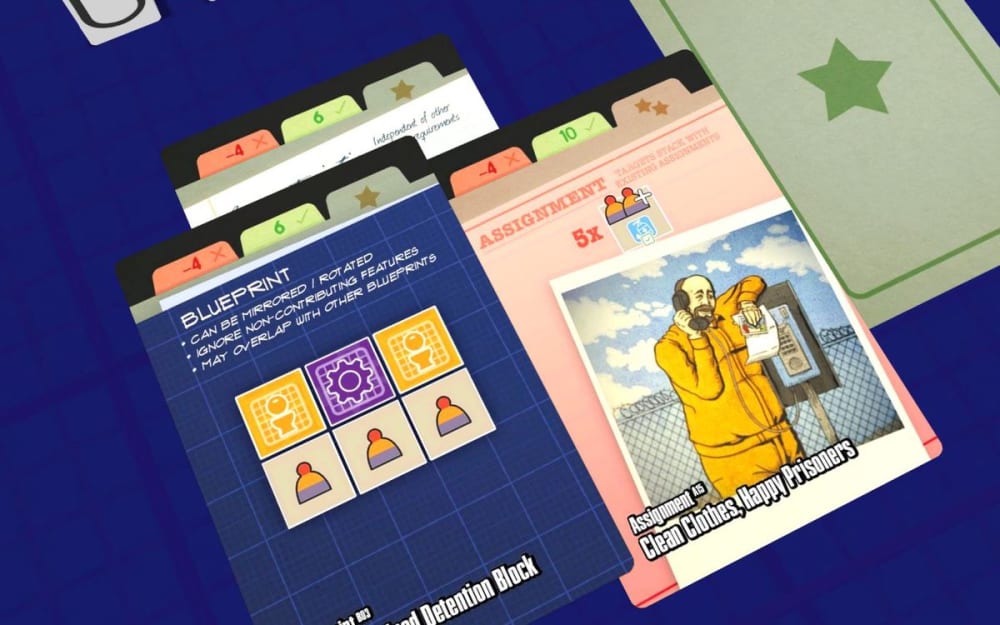
Art
The pixeled art of the video game was what originally drew me to the game. Which always works so well in the video game scene, but only a handful of games have done it will & those games aren’t on small tiles; so I wasn’t sure how that would translate.
Lewis Shaw has done a beautiful job of blending the original art, fitting all the icons & room onto the relatively small tiles. For a tiny tile, it has so much on it, but doesn’t feel cluttered & can be easily identified at a glance. It is actually something that most will probably never notice, but that isn’t easy folks & it needs to be recognized & applauded.
There are so many design elements of this game that makes the design nerd in me very happy. The use of the frame to contain your prison, it seems so simple but it fits the game so well & forces you to focus & be very mindful of the space you have. It feels like you are looking at a blueprint watching over your prison. The blueprints cards are clear, clean & crisp & the King of the Hill style artwork makes me so happy. I love that show more than I should.
And though normally I like one solid player board or tracker board that contains everything. As I find little ones, then cards & meeples can make the play space feel cluttered or messy, I don’t find that with these components. This tracker is just enough; it’s simple & clean but small enough to place above the frame to allow it to blend in & feel cohesive.
Overall, the art & design elements of this game have been handled with the finesse of someone that has decades of experience & 10s of games under their belt. Not someone that is still finding there feet in the industry. As Board Game Geek says that this is Lewis Shaw’s 4th game as artist. That is astonishing to me. Yet, Mark my words, Lewis Shaw is someone to watch!
Final Thoughts
Overall, I was a little sceptikal of Prison Architect: Cardboard County Penitentiary. That quickly when away when I heard Dávid Turczi was one of the designers (he is becoming one of my favourite designers of late). He and fellow designer, Noralie Lubbers, took an existing IP & made it feel so familiar. Then gave it their own special touches that allowed them to not just make their mark on a fan favourite, but add new way to enjoy fall in love with it all over again.
They have created a complex game that is beginner-friendly & that grows with the player, whether played with friends or solo.
This spatial puzzle of a game is highly anticipated & it lives up to all of the hype & then some. I can’t recommend Prison Architect: Cardboard County Penitentiary enough, as it lives up to everything I wanted and more. Plus the fact I have played this solo numerious times since the first games night & enjoy it as much as the video game; is a testament to the level of skill of the team behind this game.
Do yourself a favour, add this to your collection, you won’t regret it!
If you want your own copy of Prison Architect: Cardboard County Penitentiary, you can find the Kickstarter here


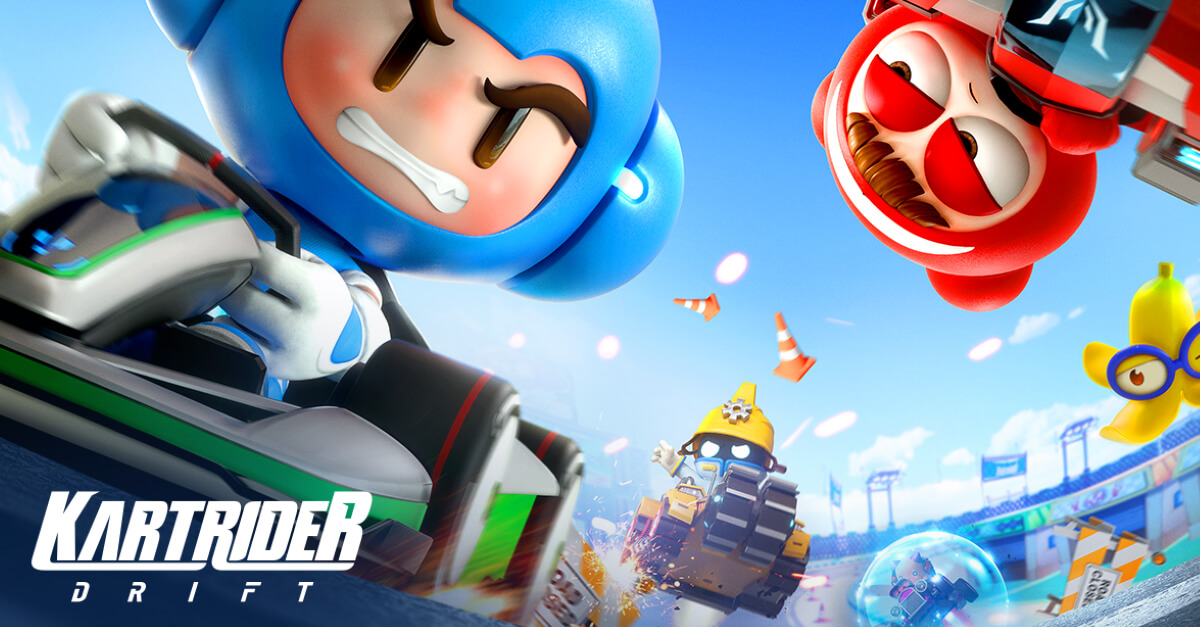



Recent Comments